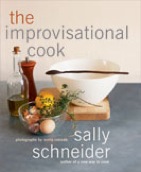
reference-image, l
(article, Megan Holden)
I am several weeks into my New Year’s resolution; I must confess that my goal to become a more relaxed, creative cook (and hence, a more spontaneous, less uptight person) has had its ups and downs. Sure, I can make small recipe adjustments — say, adding orange zest to chocolate muffins — but to innovate at the stove with my kids asking, “What’s for dinner?” is another matter altogether. I needed inspiration. Luckily for me, I found Sally Schneider's The Improvisational Cook to help me shed my type-A persona. Schneider believes that any cook — from the novice to the accomplished — can be creative. Throughout The Improvisational Cook, she models innovation by describing how she discovered new flavor combinations in her own cooking. Introductory chapters on the “Creative Mind Set” and “Understanding Flavor” will boost your confidence. Moreover, her detailed “Guide to Classic Flavor Affinities” — from Mediterranean to Asian to French to Indian — is a perfect jumping-off point for further kitchen adventures. Schneider holds your hand through the creative process. For more than 50 different techniques, she provides a “basic” recipe, an “Understanding” section, and a litany of improvisations (sans recipes). I made the basic recipe of Potatoes with White Wine, Thyme, and Olives, a Provençal dish in which potatoes are braised in wine and olive oil. The next week I tackled such innovations as Potatoes with Lemon and Olive Oil and the Asian-inspired Parsnips with Roasted Sesame Oil and Cilantro, using the same braising technique. What’s more, I skipped my measuring spoons and eyeballed the oil, salt, and spices. My resolution might just succeed after all. If I have any complaint about this book, it’s that the improvisation sections, presented in paragraph form, are difficult to use efficiently. There are no recipes to get hung up on (which is a good thing for the improviser), but a hurried cook or beginner must read carefully the improvisation section, then refer back to the basic recipe for proportions and technique. I would need to prepare the dishes several more times before innovating became second nature. The Improvisational Cook is a logical step in Sally Schneider’s cooking. Five years ago, she wrote A New Way to Cook, a primer on healthy Mediterranean cooking. Throughout A New Way to Cook, Schneider encourages cooks to improvise, but her focus is on making rich-tasting food without the calories. A tome of 600 recipes in a thick squat book that does not lie open easily on the counter, A New Way to Cook is full of techniques that extend the flavor of dishes without added fat. For example, Schneider uses flavored oils emulsified with broth to dress beans or grains, and slow-roasts fish for velvety texture and succulent taste without butter and cream. If your own improvisations don’t live up to your taste standards, you can always turn to The 150 Best American Recipes — a cooking insurance policy if ever there was one. Every year, James Beard Award-winning authors Fran McCullough and Molly Stevens scour the nation’s food world in search of outstanding recipes. After a decade of discoveries, they realized they needed a compendium for their own use — and for us, their lucky readers. This best-of-the-best cookbook compiles recipes from cookbooks, magazines, websites, and blogs, as well as from offbeat sources such as newspaper contests and supermarket fliers. Such famous chefs as Thomas Keller and Judy Rogers contribute alongside (formerly) unknown cooks. The editors cooked their way through more than 1,000 dishes to chose one 150 of the most essential, most delicious, and most useful for the busy cook. [[block(sidebar). h1.Featured recipes]] Excellent page design and more than 60 full-page stunning photographs makes this book a pleasure to read and use. Every recipe includes tips and notes from their test kitchen, offering make-ahead hints, substitutions, and practical suggestions, as well as shopping and serving ideas. I knew The 150 Best American Recipes had to be great when my initial browse turned up two of my family’s most-favorite dishes. Braised Beef Short Ribs Chinese Style is my trusty dinner-party dish, while my 10-year-old son never misses an opportunity to whip up a batch of Amazing Overnight Waffles. (This delicacy lives up to its name, wafting a yeasty aroma that will beckon even the most reluctant risers to the breakfast table.) The editors culled many brilliantly simple dishes. Five or six ingredients combine with remarkable results (including Yellow Pepper and Pine Nut Soup and delectable Tagliatelle with Crème Fraîche and Arugula). Other recipes offer reliable, quick everyday meals (Roasted Sausages and Grapes comes to mind). Finally, holiday and entertainment fare, such as North African Slow-Roasted Lamb, will dazzle your guests. The 150 Best American Recipes is full of “dead-easy, accessible, knock-your-socks-off“ dishes that will appeal to tenderfoot cooks, old hands — and even uptight ones. p(bio). Megan Holden writes about food, books, and kids in Portland, Oregon.

reference-image, l